stop start HUMMER H3 2007 User Guide
[x] Cancel search | Manufacturer: HUMMER, Model Year: 2007, Model line: H3, Model: HUMMER H3 2007Pages: 480, PDF Size: 2.73 MB
Page 125 of 480

Cleaning the Mirror
When cleaning the mirror, use a paper towel or
similar material dampened with glass cleaner.
Do not spray glass cleaner directly on the mirror
as that may cause the liquid cleaner to enter
the mirror housing.
Automatic Dimming Rearview
Mirror with Compass and
Temperature Display
Your vehicle may have this mirror. When on, an
automatic dimming mirror will dim to the proper
level to minimize glare from lights behind you
after dark.
The mirror also includes a dual display in the
upper right corner of the mirror with the compass
reading and the outside temperature.
Yb:Brie�y press this button to turn the display
on or off.
Temperature Display
The temperature can be displayed by pressing the
compass/temperature button. Pressing the
compass/temperature button once brie�y, will
toggle the display reading on and off. To alternate
the temperature reading between Fahrenheit and
Celsius, press and hold the compass/temperature
button for approximately three seconds until the
display blinks F and C. After approximately �ve
seconds of inactivity, the display will stop blinking
and display the last selection made.
If an abnormal reading is displayed, see your
dealer.
Automatic Dimming Mirror Operation
O
:Press this button to turn the automatic
dimming feature on or off. The indicator light to
the left of the button will turn on to indicate when
the feature is on. Once the mirror is turned off,
it will remain off until it is turned back on, or until
the vehicle is restarted.
125
Page 156 of 480
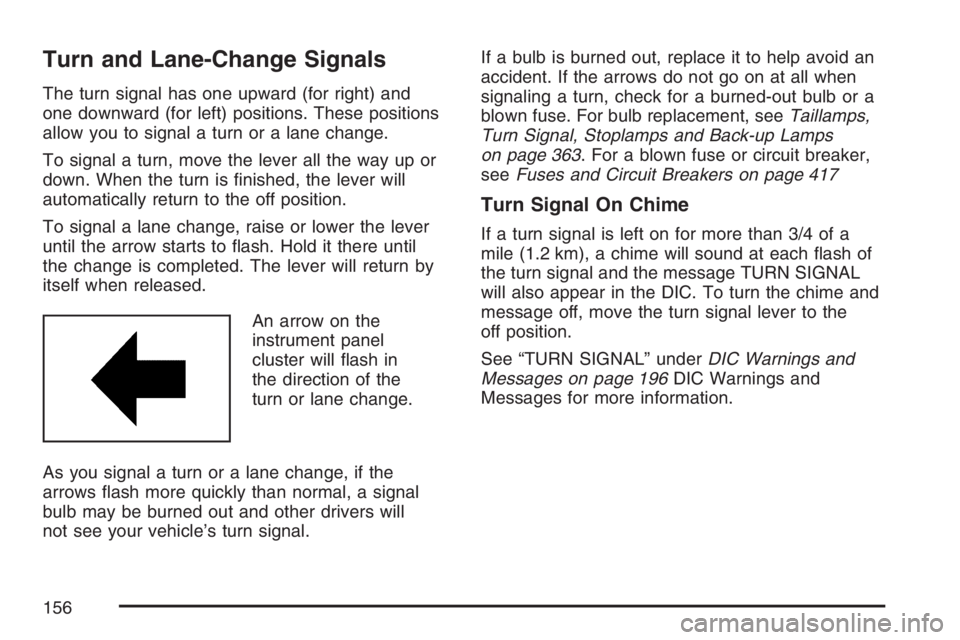
Turn and Lane-Change Signals
The turn signal has one upward (for right) and
one downward (for left) positions. These positions
allow you to signal a turn or a lane change.
To signal a turn, move the lever all the way up or
down. When the turn is �nished, the lever will
automatically return to the off position.
To signal a lane change, raise or lower the lever
until the arrow starts to �ash. Hold it there until
the change is completed. The lever will return by
itself when released.
An arrow on the
instrument panel
cluster will �ash in
the direction of the
turn or lane change.
As you signal a turn or a lane change, if the
arrows �ash more quickly than normal, a signal
bulb may be burned out and other drivers will
not see your vehicle’s turn signal.If a bulb is burned out, replace it to help avoid an
accident. If the arrows do not go on at all when
signaling a turn, check for a burned-out bulb or a
blown fuse. For bulb replacement, seeTaillamps,
Turn Signal, Stoplamps and Back-up Lamps
on page 363. For a blown fuse or circuit breaker,
seeFuses and Circuit Breakers on page 417
Turn Signal On Chime
If a turn signal is left on for more than 3/4 of a
mile (1.2 km), a chime will sound at each �ash of
the turn signal and the message TURN SIGNAL
will also appear in the DIC. To turn the chime and
message off, move the turn signal lever to the
off position.
See “TURN SIGNAL” underDIC Warnings and
Messages on page 196DIC Warnings and
Messages for more information.
156
Page 157 of 480

Headlamp High/Low-Beam Changer
53(Headlamp High/Low Beam Changer):
To change the headlamps from low to high beam,
push the lever toward the instrument panel.
To return to low-beam headlamps, pull the
multifunction lever toward you. Then release it.
When the high beams
are on, this indicator light
on the instrument panel
cluster will also be on.
Flash-to-Pass
This feature lets you use the high-beam
headlamps to signal a driver in front of you that
you want to pass. It works even if the headlamps
are in the automatic position.
To use it, pull the turn signal lever toward you,
then release it.If your headlamps are in the automatic position
or on low beam, your high-beam headlamps will
turn on. They will stay on as long as you hold the
lever toward you. The high-beam indicator on the
instrument panel cluster will come on. Release
the lever to return to normal operation.
Windshield Wipers
You control the windshield wipers by turning the
band with the wiper symbol on it.
8(Mist):Turn the band to mist for a single
wiping cycle. Hold it there until the wipers
start. Then let go. The wipers will stop after
one wipe. Hold the band on mist longer, if more
wipes are needed.
N(Delay):The wiper speed can be set for
long or short delays between wipes. This can be
very useful in light rain or snow. Turn the band
to choose the delay time. The closer to the top
of the lever, the shorter the delay.
157
Page 183 of 480

{CAUTION:
Your brake system may not be working
properly if the brake system warning
light is on. Driving with the brake system
warning light on can lead to an accident.
If the light is still on after you have pulled
off the road and stopped carefully, have
the vehicle towed for service.
Anti-Lock Brake System
Warning Light
With the Anti-Lock Brake
System (ABS), this light
will come on brie�y when
you start your engine
to show it is working.
Then it will turn off.
This is normal.
If the light stays on, or comes on when you are
driving, your vehicle needs service. If the regular
brake system warning light is not on, you still
have brakes, but you do not have anti-lock brakes.
If the regular brake system warning light is also
on, you do not have anti-lock brakes and there
is a problem with your regular brakes. SeeBrake
System Warning Light on page 182.
The ABS warning light should come on brie�y
when you turn the ignition key to ON. If the light
does not come on then, have it �xed so it will
be ready to warn you if there is a problem.
183
Page 187 of 480
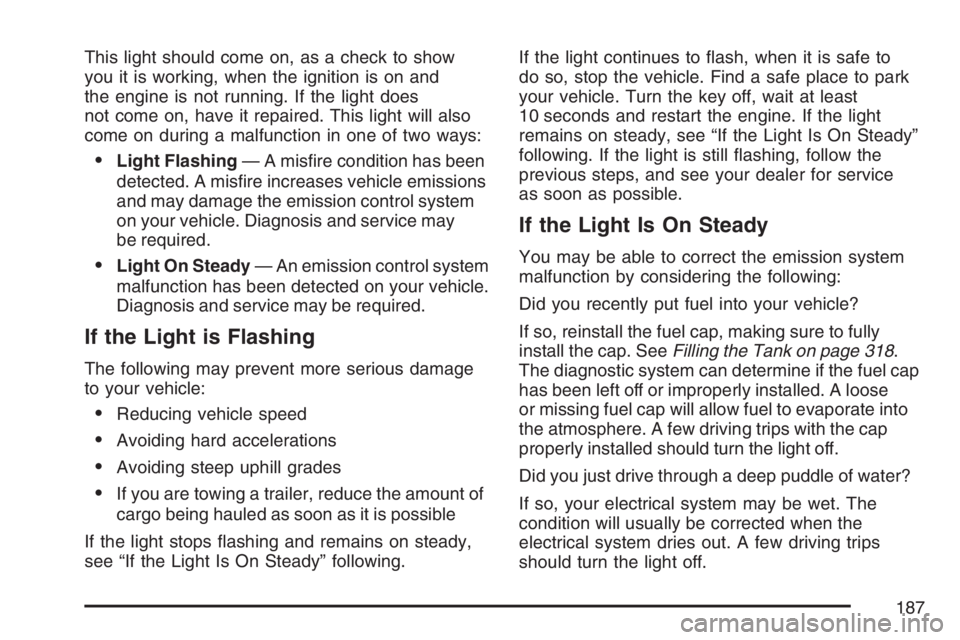
This light should come on, as a check to show
you it is working, when the ignition is on and
the engine is not running. If the light does
not come on, have it repaired. This light will also
come on during a malfunction in one of two ways:
Light Flashing— A mis�re condition has been
detected. A mis�re increases vehicle emissions
and may damage the emission control system
on your vehicle. Diagnosis and service may
be required.
Light On Steady— An emission control system
malfunction has been detected on your vehicle.
Diagnosis and service may be required.
If the Light is Flashing
The following may prevent more serious damage
to your vehicle:
Reducing vehicle speed
Avoiding hard accelerations
Avoiding steep uphill grades
If you are towing a trailer, reduce the amount of
cargo being hauled as soon as it is possible
If the light stops �ashing and remains on steady,
see “If the Light Is On Steady” following.If the light continues to �ash, when it is safe to
do so, stop the vehicle. Find a safe place to park
your vehicle. Turn the key off, wait at least
10 seconds and restart the engine. If the light
remains on steady, see “If the Light Is On Steady”
following. If the light is still �ashing, follow the
previous steps, and see your dealer for service
as soon as possible.
If the Light Is On Steady
You may be able to correct the emission system
malfunction by considering the following:
Did you recently put fuel into your vehicle?
If so, reinstall the fuel cap, making sure to fully
install the cap. SeeFilling the Tank on page 318.
The diagnostic system can determine if the fuel cap
has been left off or improperly installed. A loose
or missing fuel cap will allow fuel to evaporate into
the atmosphere. A few driving trips with the cap
properly installed should turn the light off.
Did you just drive through a deep puddle of water?
If so, your electrical system may be wet. The
condition will usually be corrected when the
electrical system dries out. A few driving trips
should turn the light off.
187
Page 208 of 480
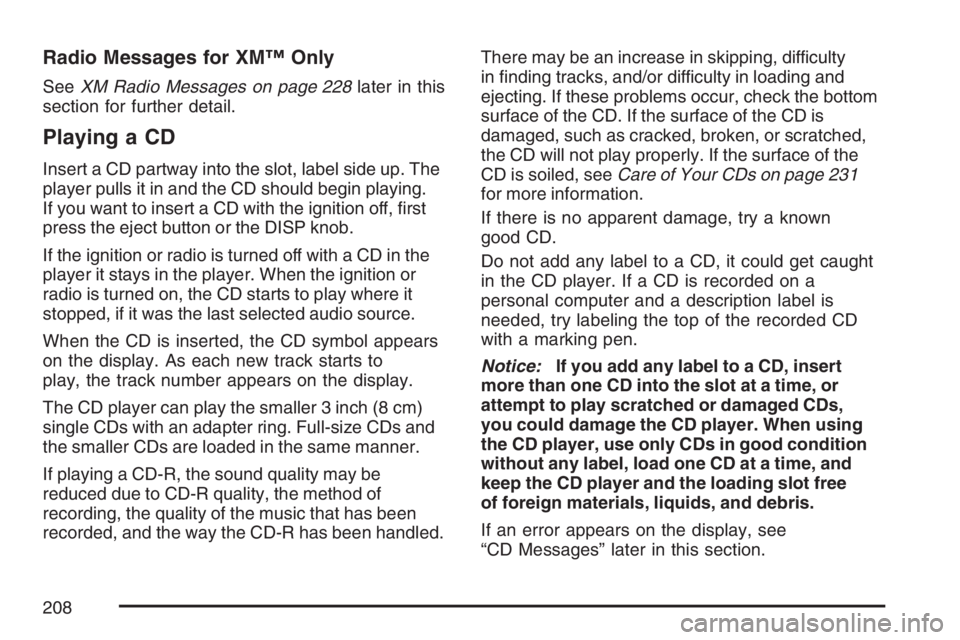
Radio Messages for XM™ Only
SeeXM Radio Messages on page 228later in this
section for further detail.
Playing a CD
Insert a CD partway into the slot, label side up. The
player pulls it in and the CD should begin playing.
If you want to insert a CD with the ignition off, �rst
press the eject button or the DISP knob.
If the ignition or radio is turned off with a CD in the
player it stays in the player. When the ignition or
radio is turned on, the CD starts to play where it
stopped, if it was the last selected audio source.
When the CD is inserted, the CD symbol appears
on the display. As each new track starts to
play, the track number appears on the display.
The CD player can play the smaller 3 inch (8 cm)
single CDs with an adapter ring. Full-size CDs and
the smaller CDs are loaded in the same manner.
If playing a CD-R, the sound quality may be
reduced due to CD-R quality, the method of
recording, the quality of the music that has been
recorded, and the way the CD-R has been handled.There may be an increase in skipping, difficulty
in �nding tracks, and/or difficulty in loading and
ejecting. If these problems occur, check the bottom
surface of the CD. If the surface of the CD is
damaged, such as cracked, broken, or scratched,
the CD will not play properly. If the surface of the
CD is soiled, seeCare of Your CDs on page 231
for more information.
If there is no apparent damage, try a known
good CD.
Do not add any label to a CD, it could get caught
in the CD player. If a CD is recorded on a
personal computer and a description label is
needed, try labeling the top of the recorded CD
with a marking pen.
Notice:If you add any label to a CD, insert
more than one CD into the slot at a time, or
attempt to play scratched or damaged CDs,
you could damage the CD player. When using
the CD player, use only CDs in good condition
without any label, load one CD at a time, and
keep the CD player and the loading slot free
of foreign materials, liquids, and debris.
If an error appears on the display, see
“CD Messages” later in this section.
208
Page 209 of 480
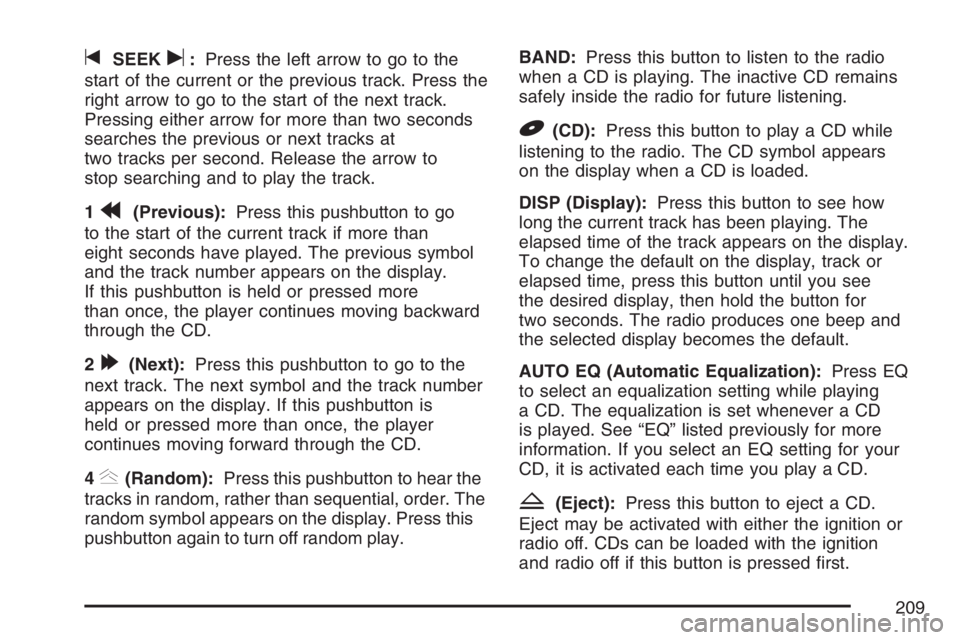
tSEEKu:Press the left arrow to go to the
start of the current or the previous track. Press the
right arrow to go to the start of the next track.
Pressing either arrow for more than two seconds
searches the previous or next tracks at
two tracks per second. Release the arrow to
stop searching and to play the track.
1
r(Previous):Press this pushbutton to go
to the start of the current track if more than
eight seconds have played. The previous symbol
and the track number appears on the display.
If this pushbutton is held or pressed more
than once, the player continues moving backward
through the CD.
2
[(Next):Press this pushbutton to go to the
next track. The next symbol and the track number
appears on the display. If this pushbutton is
held or pressed more than once, the player
continues moving forward through the CD.
4
y(Random):Press this pushbutton to hear the
tracks in random, rather than sequential, order. The
random symbol appears on the display. Press this
pushbutton again to turn off random play.BAND:Press this button to listen to the radio
when a CD is playing. The inactive CD remains
safely inside the radio for future listening.
B(CD):Press this button to play a CD while
listening to the radio. The CD symbol appears
on the display when a CD is loaded.
DISP (Display):Press this button to see how
long the current track has been playing. The
elapsed time of the track appears on the display.
To change the default on the display, track or
elapsed time, press this button until you see
the desired display, then hold the button for
two seconds. The radio produces one beep and
the selected display becomes the default.
AUTO EQ (Automatic Equalization):Press EQ
to select an equalization setting while playing
a CD. The equalization is set whenever a CD
is played. See “EQ” listed previously for more
information. If you select an EQ setting for your
CD, it is activated each time you play a CD.
Z(Eject):Press this button to eject a CD.
Eject may be activated with either the ignition or
radio off. CDs can be loaded with the ignition
and radio off if this button is pressed �rst.
209
Page 216 of 480
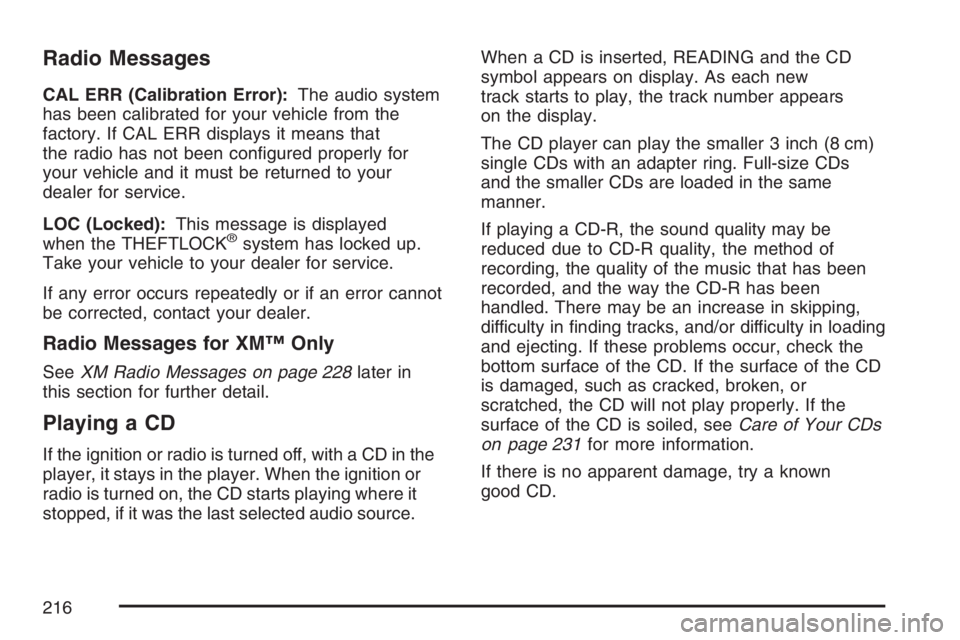
Radio Messages
CAL ERR (Calibration Error):The audio system
has been calibrated for your vehicle from the
factory. If CAL ERR displays it means that
the radio has not been con�gured properly for
your vehicle and it must be returned to your
dealer for service.
LOC (Locked):This message is displayed
when the THEFTLOCK
®system has locked up.
Take your vehicle to your dealer for service.
If any error occurs repeatedly or if an error cannot
be corrected, contact your dealer.
Radio Messages for XM™ Only
SeeXM Radio Messages on page 228later in
this section for further detail.
Playing a CD
If the ignition or radio is turned off, with a CD in the
player, it stays in the player. When the ignition or
radio is turned on, the CD starts playing where it
stopped, if it was the last selected audio source.When a CD is inserted, READING and the CD
symbol appears on display. As each new
track starts to play, the track number appears
on the display.
The CD player can play the smaller 3 inch (8 cm)
single CDs with an adapter ring. Full-size CDs
and the smaller CDs are loaded in the same
manner.
If playing a CD-R, the sound quality may be
reduced due to CD-R quality, the method of
recording, the quality of the music that has been
recorded, and the way the CD-R has been
handled. There may be an increase in skipping,
difficulty in �nding tracks, and/or difficulty in loading
and ejecting. If these problems occur, check the
bottom surface of the CD. If the surface of the CD
is damaged, such as cracked, broken, or
scratched, the CD will not play properly. If the
surface of the CD is soiled, seeCare of Your CDs
on page 231for more information.
If there is no apparent damage, try a known
good CD.
216
Page 219 of 480
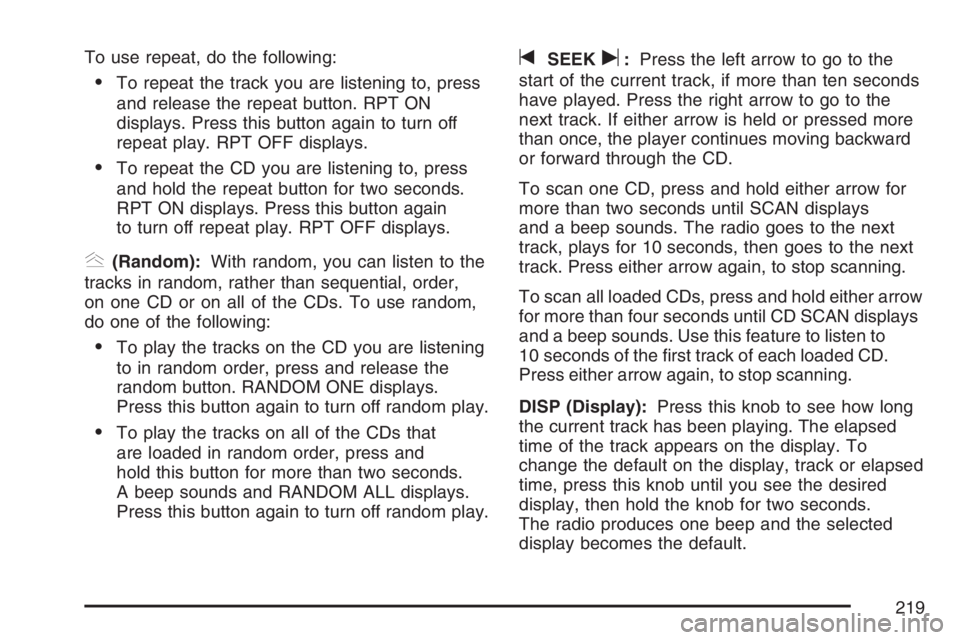
To use repeat, do the following:
To repeat the track you are listening to, press
and release the repeat button. RPT ON
displays. Press this button again to turn off
repeat play. RPT OFF displays.
To repeat the CD you are listening to, press
and hold the repeat button for two seconds.
RPT ON displays. Press this button again
to turn off repeat play. RPT OFF displays.
y(Random):With random, you can listen to the
tracks in random, rather than sequential, order,
on one CD or on all of the CDs. To use random,
do one of the following:
To play the tracks on the CD you are listening
to in random order, press and release the
random button. RANDOM ONE displays.
Press this button again to turn off random play.
To play the tracks on all of the CDs that
are loaded in random order, press and
hold this button for more than two seconds.
A beep sounds and RANDOM ALL displays.
Press this button again to turn off random play.
tSEEKu:Press the left arrow to go to the
start of the current track, if more than ten seconds
have played. Press the right arrow to go to the
next track. If either arrow is held or pressed more
than once, the player continues moving backward
or forward through the CD.
To scan one CD, press and hold either arrow for
more than two seconds until SCAN displays
and a beep sounds. The radio goes to the next
track, plays for 10 seconds, then goes to the next
track. Press either arrow again, to stop scanning.
To scan all loaded CDs, press and hold either arrow
for more than four seconds until CD SCAN displays
and a beep sounds. Use this feature to listen to
10 seconds of the �rst track of each loaded CD.
Press either arrow again, to stop scanning.
DISP (Display):Press this knob to see how long
the current track has been playing. The elapsed
time of the track appears on the display. To
change the default on the display, track or elapsed
time, press this knob until you see the desired
display, then hold the knob for two seconds.
The radio produces one beep and the selected
display becomes the default.
219
Page 225 of 480

If the ignition or radio is turned off with a CD in the
player it stays in the player. When the ignition or
radio is turned on, the CD starts to play where it
stopped, if it was the last selected audio source.
As each new track starts to play, the track number
appears on the display.
The CD player can play the smaller 3 inch (8 cm)
single CDs with an adapter ring. Full-size CDs
and the smaller CDs are loaded in the same
manner.
If playing a CD-R, the sound quality may be
reduced due to CD-R quality, the method of
recording, the quality of the music that has been
recorded, and the way the CD-R has been
handled. There may be an increase in skipping,
difficulty in �nding tracks, and/or difficulty in loading
and ejecting. If these problems occur, check
the bottom surface of the CD. If the surface of
the CD is damaged, such as cracked, broken,
or scratched, the CD will not play properly.
If the surface of the CD is soiled, seeCare of
Your CDs on page 231for more information.
If there is no apparent damage, try a known
good CD.Do not add any label to a CD, it could get caught
in the CD player. If a CD is recorded on a
personal computer and a description label is
needed, try labeling the top of the recorded CD
with a marking pen.
Notice:If you add any label to a CD, insert
more than one CD into the slot at a time, or
attempt to play scratched or damaged CDs,
you could damage the CD player. When using
the CD player, use only CDs in good condition
without any label, load one CD at a time, and
keep the CD player and the loading slot free
of foreign materials, liquids, and debris.
If an error appears on the display, see
“CD Messages” later in this section.
tSEEKu:Press the left arrow to go to the
start of the previous track. Press the right arrow
to go to the start of the next track. Pressing either
arrow for more than two seconds searches the
previous or next tracks at two tracks per second.
Release the button to stop searching and to
play the track.
225